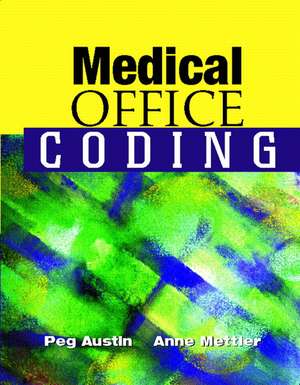Medical Office Coding
Autor Peg Austin, Anne Mettler, Rhia Ccs-P Cpc Austin Pegen Limba Engleză Paperback – 28 feb 2005
Preț: 657.95 lei
Preț vechi: 692.58 lei
-5% Nou
Puncte Express: 987
Preț estimativ în valută:
125.90€ • 131.80$ • 104.17£
125.90€ • 131.80$ • 104.17£
Carte indisponibilă temporar
Doresc să fiu notificat când acest titlu va fi disponibil:
Se trimite...
Preluare comenzi: 021 569.72.76
Specificații
ISBN-13: 9780131425323
ISBN-10: 0131425323
Pagini: 592
Dimensiuni: 231 x 263 x 31 mm
Greutate: 1.08 kg
Ediția:1
Editura: Pearson
Locul publicării:Upper Saddle River, United States
ISBN-10: 0131425323
Pagini: 592
Dimensiuni: 231 x 263 x 31 mm
Greutate: 1.08 kg
Ediția:1
Editura: Pearson
Locul publicării:Upper Saddle River, United States
Descriere
For introduction to medical assisting, health information management, and administrative medical assisting courses.
The first text to integrate ICD-9 (diagnosis) and CPT (procedure) codes so that learning the material mirrors the way codes are applied in a business environment. In addition, students develop hands-on practice coding real operative reports. The comprehensive textbook/workbook format encompasses basic anatomy, terminology, ICD-9 coding, CPT coding, and HCPCS coding..
The first text to integrate ICD-9 (diagnosis) and CPT (procedure) codes so that learning the material mirrors the way codes are applied in a business environment. In addition, students develop hands-on practice coding real operative reports. The comprehensive textbook/workbook format encompasses basic anatomy, terminology, ICD-9 coding, CPT coding, and HCPCS coding..
Cuprins
1. Introduction to coding
2. Introduction to ICD-9
3. Introduction to CPT
4. Evaluation and Management
5. Anesthesia Services
6. Introduction to Surgery
7. The Integumentary System
8. The Musculoskeletal System
9. The Respiratory System
10. The Cardiovascular System
11. Hematology and Lymphatic Systems/Mediastinum and Diaphragm/Endocrine
12. The Digestive System
13. The Urinary System
14. The Male Reproductive System
15. The Female Reproductive System
16. Maternity and Delivery
17. The Nervous System
18. The Eye and Ocular Adnexa/Auditory System
19. Radiology Services
20. Pathology and Laboratory Services
21. Medicine
22. Billing and Reimbursement
Appendix A - Anatomy Plates
2. Introduction to ICD-9
3. Introduction to CPT
4. Evaluation and Management
5. Anesthesia Services
6. Introduction to Surgery
7. The Integumentary System
8. The Musculoskeletal System
9. The Respiratory System
10. The Cardiovascular System
11. Hematology and Lymphatic Systems/Mediastinum and Diaphragm/Endocrine
12. The Digestive System
13. The Urinary System
14. The Male Reproductive System
15. The Female Reproductive System
16. Maternity and Delivery
17. The Nervous System
18. The Eye and Ocular Adnexa/Auditory System
19. Radiology Services
20. Pathology and Laboratory Services
21. Medicine
22. Billing and Reimbursement
Appendix A - Anatomy Plates
Caracteristici
EXAMPLES AND RATIONALE:
Embedded examples are followed by rationales which provide students with insights and alert them to discussion points.
Explanation of common disease processes—Followed by ICD-9 coding instructions and practice. Students get an understanding of common diseases and conditions for each body system prior to learning the CPT procedural codes.
Table format of diagnoses and procedures—Easy to understand. Organizes diagnoses and procedures so that students can process and remember them easily.
Linking exercises in each chapter - Demonstrate the importance and medical necessity for each procedure, and sharpen critical thinking and reasoning skills.
FORMULA FOR SUCCESS BOXES boxes provide useful tips and reminders from experienced coders. They help students avoid common mishaps. This helps students with code assignment, interpretation or reimbursement issues.
Comprehensive exercises and real-life case studies. Teach students to read physician dictation by utilizing actual operative reports that have not been condensed or paraphrased.
Photographs and illustrations—Visual depictions of medical procedures and disease processes. Encourage students to associate the picture with the written report in order to locate the correct code.
Embedded examples are followed by rationales which provide students with insights and alert them to discussion points.
Explanation of common disease processes—Followed by ICD-9 coding instructions and practice. Students get an understanding of common diseases and conditions for each body system prior to learning the CPT procedural codes.
Table format of diagnoses and procedures—Easy to understand. Organizes diagnoses and procedures so that students can process and remember them easily.
Linking exercises in each chapter - Demonstrate the importance and medical necessity for each procedure, and sharpen critical thinking and reasoning skills.
FORMULA FOR SUCCESS BOXES boxes provide useful tips and reminders from experienced coders. They help students avoid common mishaps. This helps students with code assignment, interpretation or reimbursement issues.
Comprehensive exercises and real-life case studies. Teach students to read physician dictation by utilizing actual operative reports that have not been condensed or paraphrased.
Photographs and illustrations—Visual depictions of medical procedures and disease processes. Encourage students to associate the picture with the written report in order to locate the correct code.
Textul de pe ultima copertă
This book offers integrated coverage of procedural (ICD-9) and CPT codes (diagnosis) and hands-on practice coding real operative reports. Offers readers a comprehensive workbook format that encompasses basic anatomy, terminology, ICD-9 coding, CPT coding, HCPCS coding, and real-life coding scenarios with operative reports. An excellent reference for coders currently working in the field, and a good tool for employers to test perspective employees.
